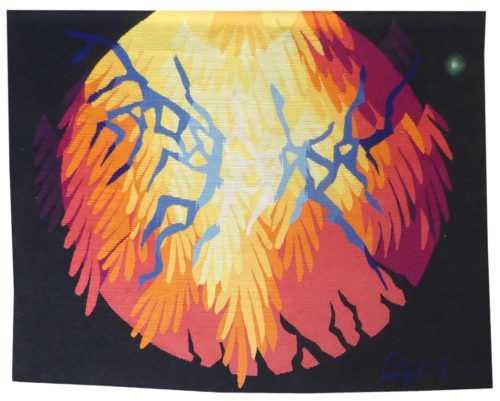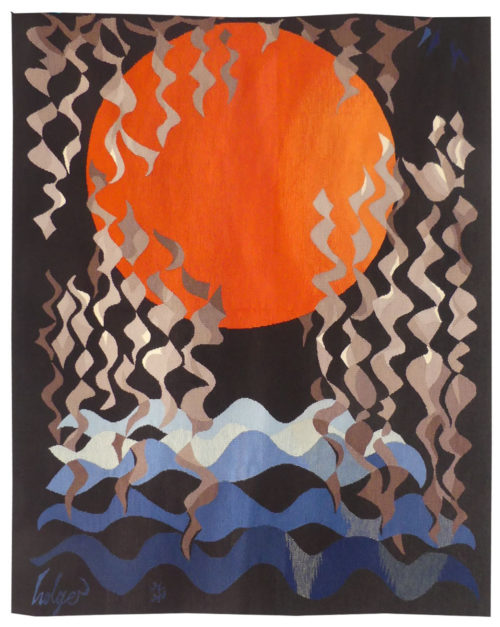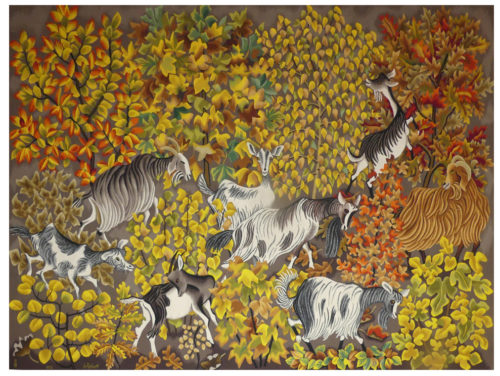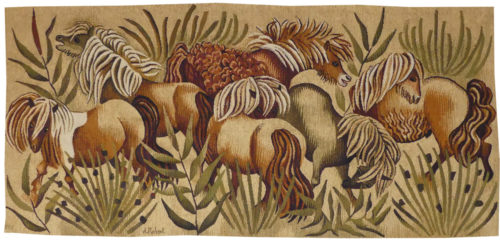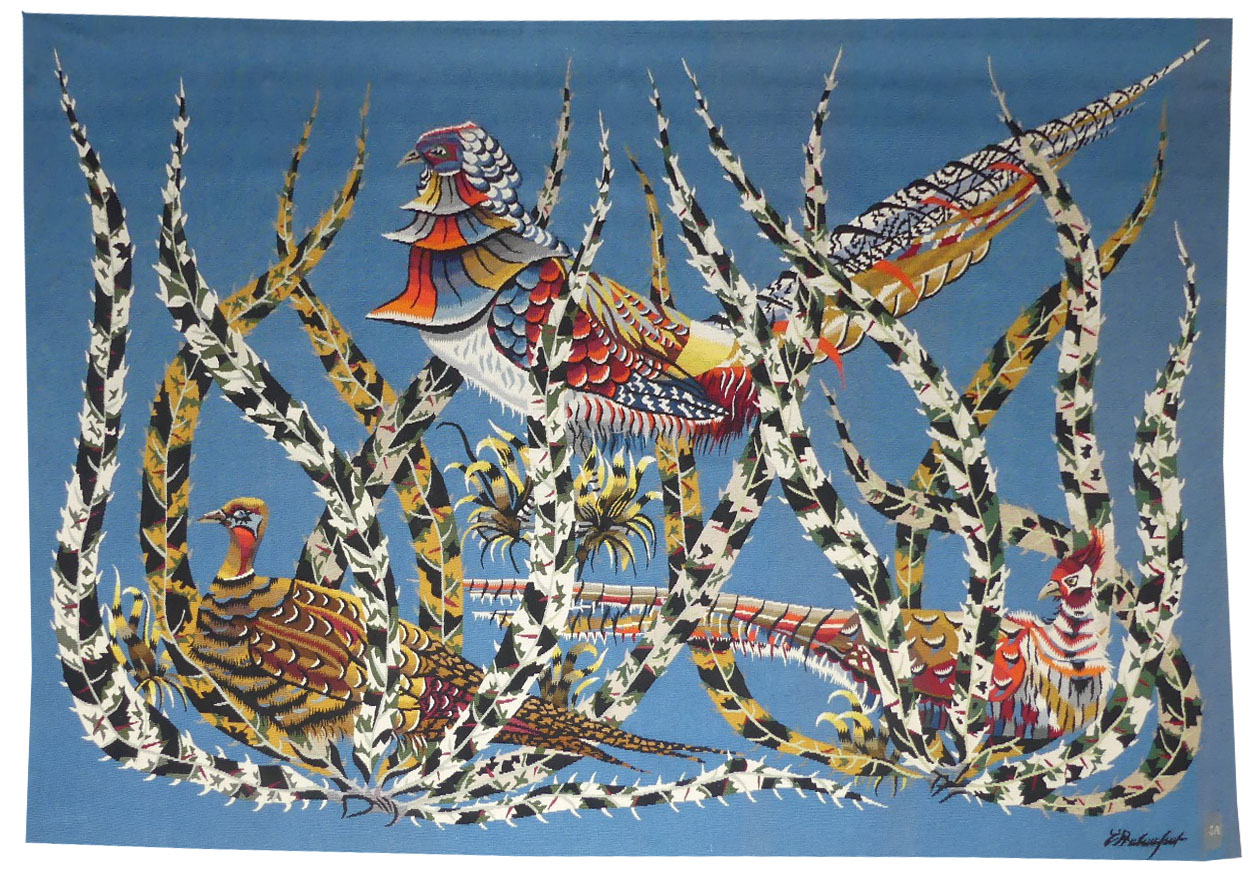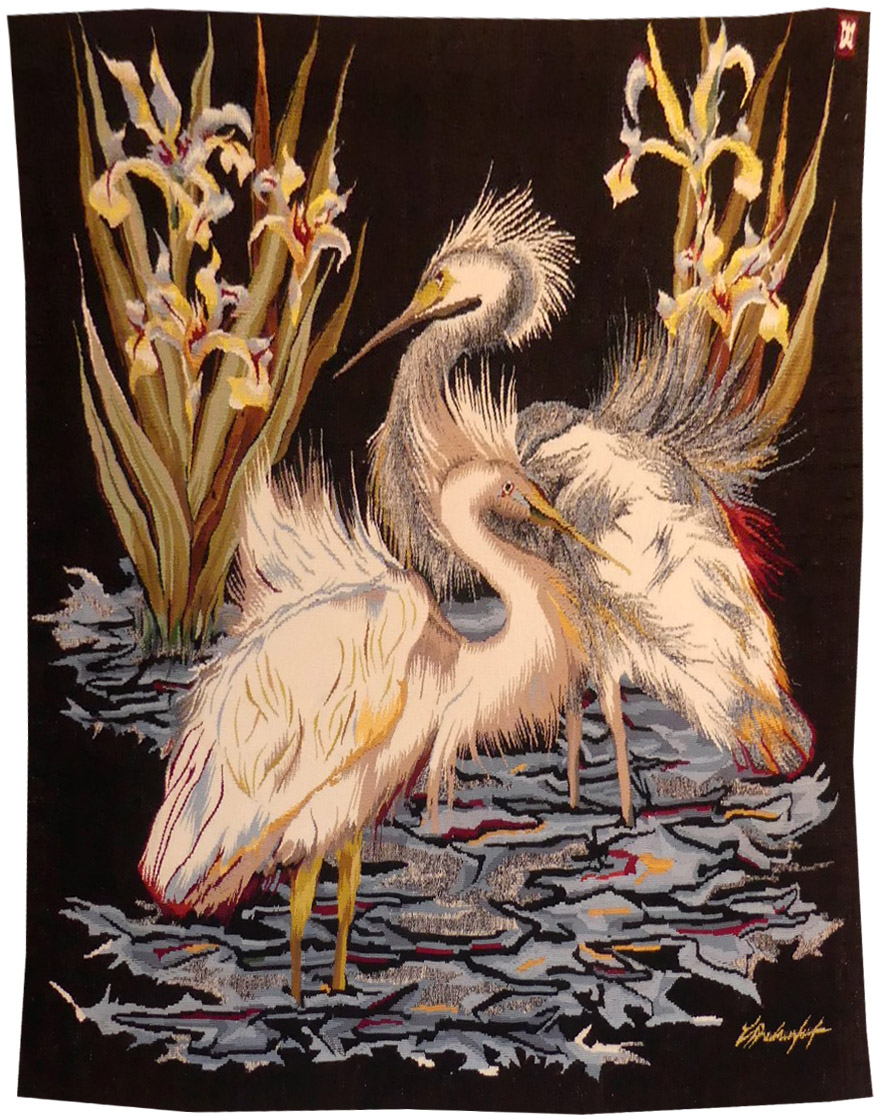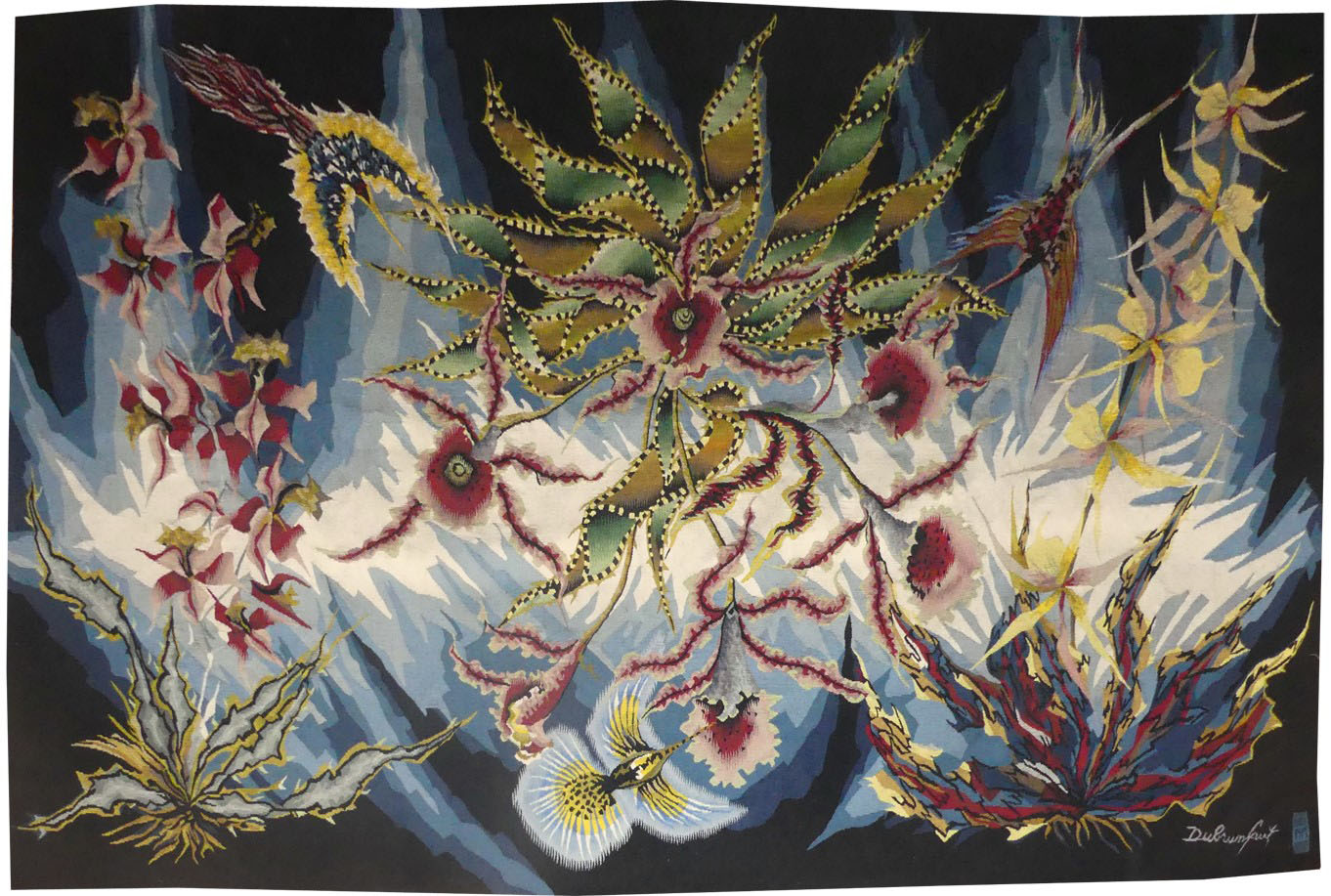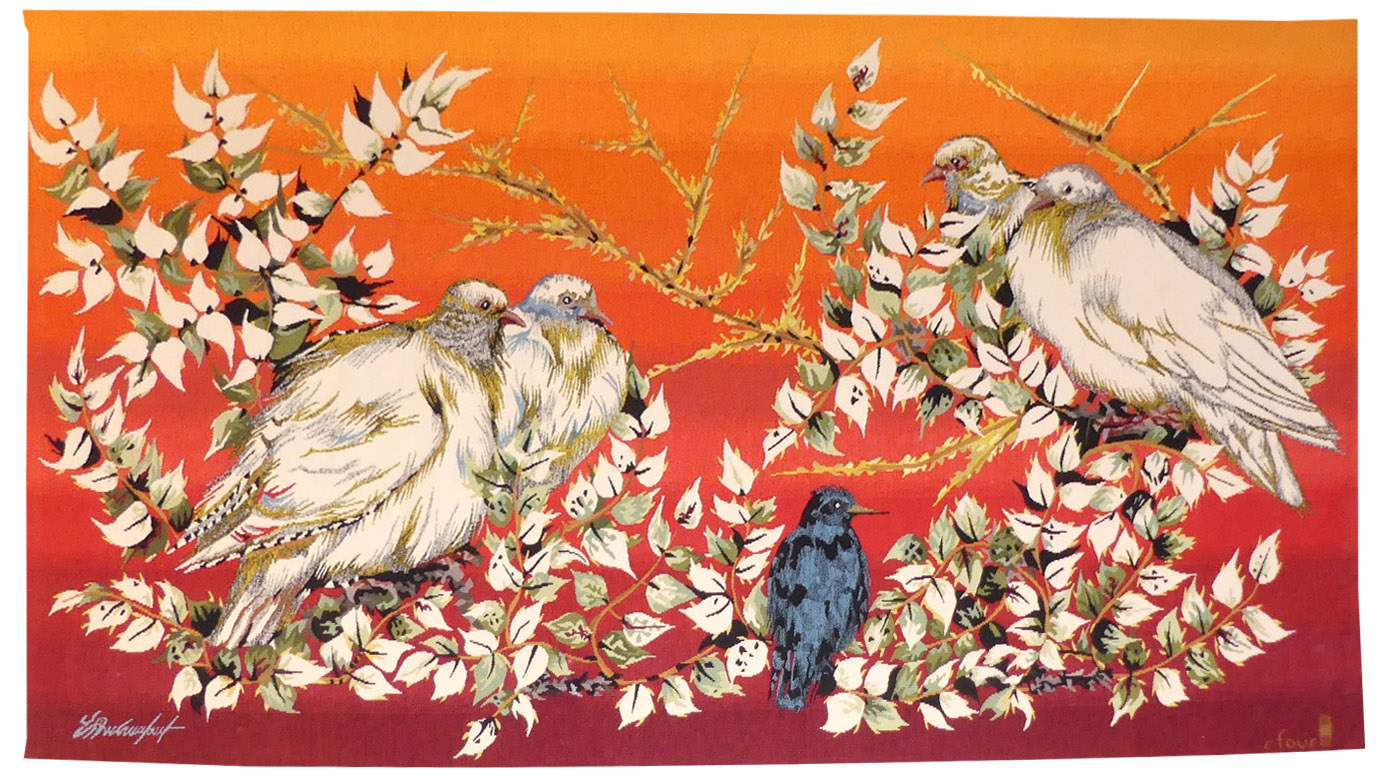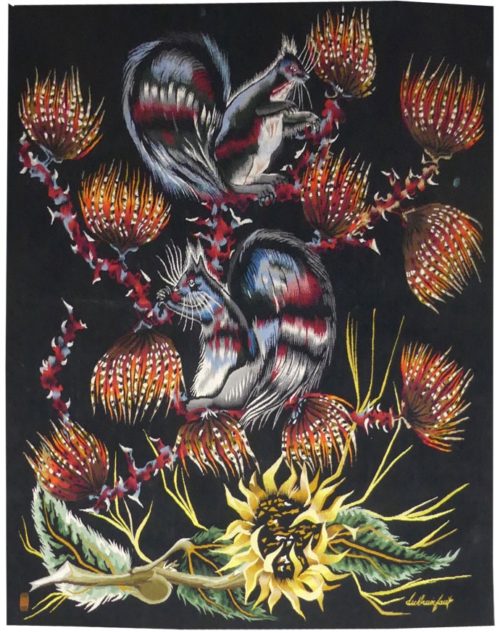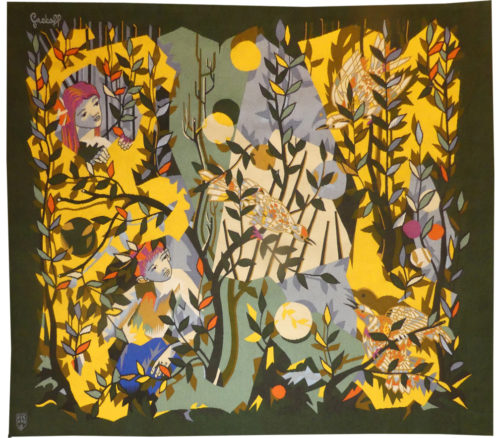-
Nachtsonne (Nightsun)
Tapestry woven by the Münchener Gobelin Manufaktur. With signed label. Circa 1970.Holger was a student at the Ecole Nationale d’Art Décoratif d’Aubusson and worked with Lurçat before the latter’s death in 1966. He designed numerous dream-like cartoons woven by the Aubusson workshop. Now settled in the United States, he remains a tireless advocate for, and witness to, modern tapestry design, organising exhibitions and lectures on the subject. Some of his cartoons have been woven in the two workshops active in Germany, in Nuremberg and Munich, using Aubusson techniques. -
Chèvrefeuilles (Honeysuckle/Goats and leaves)
Aubusson tapestry woven in the Goubely workshop. With signed label, n°1. 1973. A Benedictine monk and an illuminator, Dom Robert met Jean Lurçat in 1941 at the Abbey of En Calcat : while he never abandoned drawing (his watercolours, painted to life, would serve him as a reservoir of ideas for his tapestries), his work as a cartoonist (he was a member of the A.P.C.T. from its inception) would take on a considerable importance (at least a hundred cartoons, all numbered) and would be highly thought of. His immediately recognisable style, absence of perspective¸motifs inspired from the natural world (in a Paradisiac style) where stylised flora and fauna combine in a festive and extrovert exuberance, where the influence of mediaeval tapestry can be clearly felt ; poetic and colourful, Dom Robert’s cartoons are the incarnation of their author’s spiritual asceticism. Inaugurated in the Spring of 2015, the musée Dom Robert opened its doors in in the monastery-school in Sorèze in the department of the Tarn. Goats and foliage in all their variety, rather than « Honeysuckle » (Chèvre means goat and feuille means leaf in French n.tr.), Dom Robert was never one to turn his back on the possibility of a pun (as in “Plein champ” meaning Open field but to the ear it can be confused with Plainchant tr.n.). It is interesting that a goat appears also in that tapestry design from 1970. Here, on a uniquely large scale for this subject, the goats are displayed against an autumnal background, a reference to “l’Automne” (Autumn) which was the last of the series The Seasons completed in 1943. A similar design is on display at the Cité Internationale de la Tapisserie in Aubusson. Bibliography : Exhibition Catalogue Dom Robert, tapisseries récentes, galerie la Demeure, 1974, ill. p.15, cartoon p.23 Multi-authored, Dom Robert, Tapisseries, Editions Julliard, 1980, ill p.70-71, detail on front cover, cartoon p.85 Multi-authored, Dom Robert, Tapisseries, Editions Siloë-Sodec, 1990, ill. P.62-67 Exhibition Catalogue, Dom Robert, œuvre tissé, Angers, Musée Jean Lurçat et de la tapisserie contemporaine, 1990 Exhibition Catalogue, Hommage à Dom Robert, Musée départemental de la tapisserie, Aubusson, 1998 Multi-authored, la clef des champs, Dom Robert, Editions Privat, 2003, ill. p.124 Multi-authored, les saisons de Dom Robert, Tapisseries, Editions Hazan, 2014, ill p.164-167 B. Ythier, Guide du visiteur, Cité Internationale de la tapisserie d’Aubusson, ill. p.65 R. Guinot, hors-série la Montagne, une Cité pour la tapisserie d’Aubusson, 2018, ill. p.82 Multi-authored, la tapisserie française, Editions du Patrimoine, 2017, ill. 312-313 -
Aubusson tapestry woven in the Novion workshop. With label. 1973.A Benedictine monk and an illuminator, Dom Robert met Jean Lurçat in 1941 at the Abbey of En Calcat : while he never abandoned drawing (his watercolours, painted to life, would serve him as a reservoir of ideas for his tapestries), his work as a cartoonist (he was a member of the A.P.C.T. from its inception) would take on a considerable importance (at least a hundred cartoons, all numbered) and would be highly thought of. His immediately recognisable style, absence of perspective¸motifs inspired from the natural world (in a Paradisiac style) where stylised flora and fauna combine in a festive and extrovert exuberance, where the influence of mediaeval tapestry can be clearly felt ; poetic and colourful, Dom Robert’s cartoons are the incarnation of their author’s spiritual asceticism. Inaugurated in the Spring of 2015, the musée Dom Robert opened its doors in in the monastery-school in Sorèze in the department of the Tarn. Although the theme of horses runs through a lot of Dom Robert’s work (cf. “Dartmoor”, “Compagnons de la Marjolaine”, « Farfadet » …), what makes « Technique de groupe » particularly interesting is its origin and the technical aspects of its realisation : unusually, this cartoon is not numbered ; it was Novion, at the time a teacher at the Ecole Nationale d’Art Décoratif in Aubusson, who asked dom Robert to make a watercolour (now held at the museum in Sorèze), thus allowing the weaver more interpretative freedom, and a very different end result, from work made by the workshops of Goubely or Tabard. Bibliography : Cat. Expo. Dom Robert, tapisseries récentes, Paris, Galerie la Demeure, 1974, ill. p.9 Multi-authored, Dom Robert, Tapisseries, Editions Julliard, 1980, ill. p.68-69 Multi-authored, Dom Robert, Tapisseries, Editions Siloë-Sodec, 1990, ill. p.116-117 Exhibition Catalogue, Dom Robert, œuvre tissé, Angers, Musée Jean Lurçat et de la tapisserie contemporaine, 1990, ill. Multi-authored, la clef des champs, Dom Robert, Editions Privat, 2003, ill. p. 109
-
Le royal (King pheasant)
Edmond Dubrunfaut can be considered as the great 20th century renovator of the Belgian tapestry tradition. He founded a weavers’ workshop in Tournai as early as 1942, then, in 1947, created the Centre de Rénovation de la Tapisserie de Tournai. He produced for various Belgian workshops (Chaudoir, de Wit,...) numerous cartoons destined notably to adorn Belgian embassies throughout the world. Moreover, Dubrunfaut was a teacher of monumental art forms at the Academie des Beaux-Arts de Mons from 1947 to 1978 and then, in 1979, contributed to the creation of the Fondation de la tapisserie, des arts du tissu et des arts muraux de Tournai, a veritable heritage centre for the art of the tapestry in Wallonie. His style, characterised by figuration, strong colour contrasts, draws direct inspiration from nature and animal life (as with Perrot, for example, this artist has a net predilection for birdlife). Both the subject and the bright blue background are an echo of Perrot’s work. Also characteristic of Dubrunfaut are the feather-leaves : the animal clothes itself in vegetation.Aubusson tapestry woven in the Simone André workshop. With signed label. Circa 1965. -
Au crépuscule (at dusk)
Edmond Dubrunfaut can be considered as the great 20th century renovator of the Belgian tapestry tradition. He founded a weavers’ workshop in Tournai as early as 1942, then, in 1947, created the Centre de Rénovation de la Tapisserie de Tournai. He produced for various Belgian workshops (Chaudoir, de Wit,…) numerous cartoons destined notably to adorn Belgian embassies throughout the world. Moreover, Dubrunfaut was a teacher of monumental art forms at the Academie des Beaux-Arts de Mons from 1947 to 1978 and then, in 1979, contributed to the creation of the Fondation de la tapisserie, des arts du tissu et des arts muraux de Tournai, a veritable heritage centre for the art of the tapestry in Wallonie. His style, characterised by figuration, strong colour contrasts, draws direct inspiration from nature and animal life (as with Perrot, for example, this artist has a net predilection for birdlife). In this respect, this cartoon is characteristic of the aforementioned predilection, but here the realistic representation of the motif is a departure from Perrot’s habitual stylisation. Bibliography : Exhibition catalogue Dubrunfaut et la renaissance de la tapisserie, tableaux, dessins, peintures, Musée des Beaux-Arts de Mons, 1982-1983, n°254.Tapestry woven in the DMW workshop. With signed label. 1974. -
Flore des tropiques (tropical flora)
Aubusson tapestry woven in the Four workshop. With label, n°EA. Circa 1975.Bibliography : Exhibition catalogue Dubrunfaut et la renaissance de la tapisserie, tableaux, dessins, peintures, Musée des Beaux-Arts de Mons, 1982-1983Edmond Dubrunfaut can be considered as the great 20th century renovator of the Belgian tapestry tradition. He founded a weavers’ workshop in Tournai as early as 1942, then, in 1947, created the Centre de Rénovation de la Tapisserie de Tournai. He produced for various Belgian workshops (Chaudoir, de Wit,...) numerous cartoons destined notably to adorn Belgian embassies throughout the world. Moreover, Dubrunfaut was a teacher of monumental art forms at the Academie des Beaux-Arts de Mons from 1947 to 1978 and then, in 1979, contributed to the creation of the Fondation de la tapisserie, des arts du tissu et des arts muraux de Tournai, a veritable heritage centre for the art of the tapestry in Wallonie. His style, characterised by figuration, strong colour contrasts, draws direct inspiration from nature and animal life (as with Perrot, for example, this artist has a net predilection for birdlife). Towards the end of his career, Dubrunfaut tended to a language of fantasy (whose sharpened forms are reminiscent of Marc Petit), and whose use of motif (humming birds and exotic vegetation) looks over its shoulder at Lurçat. -
Double amitié (double friendship)
Aubusson tapestry woven in the Four workshop. With signed label, n°EA1. 1972. -
Feux du soir (Evening sparkles)
Aubusson tapestry woven in the Simone André workshop. Complete with signed label. Circa 1970. Edmond Dubrunfaut can be considered as the great 20th century renovator of the Belgian tapestry tradition. He founded a weavers’ workshop in Tournai as early as 1942, then, in 1947, created the Centre de Rénovation de la Tapisserie de Tournai. He produced for various Belgian workshops (Chaudoir, de Wit,...) numerous cartoons destined notably to adorn Belgian embassies throughout the world. Moreover, Dubrunfaut was a teacher of monumental art forms at the Academie des Beaux-Arts de Mons from 1947 to 1978 and then, in 1979, contributed to the creation of the Fondation de la tapisserie, des arts du tissu et des arts muraux de Tournai, a veritable heritage centre for the art of the tapestry in Wallonie. His style, characterised by figuration, strong colour contrasts, draws direct inspiration from nature and animal life (as with Perrot, for example, this artist has a net predilection for birdlife). Between a sunflower (a recurrent flower in Dubrunfaut’s work) and hazlenuts, scorning any reference to scale, the squirrels go about their business of procuring food : from this humdrum task, Dubrunfaut produces, by way of his title, a poetic effect in a dreamlike style. -
Le petit oiseleur (the little bird-catcher)
Aubusson tapestry woven by the Picaud workshop. With label, n°1/6. Circa 1970.Elie Grekoff, whose aesthetic is similar to that of Lurçat, designed over 300 cartons.“The little bird catcher” is typical of a vein characteristic of Grekoff where melancholic children consider each other within a dream-like landscape against a background of large flat areas of colour, redolent of an illustration for a folk tale.


